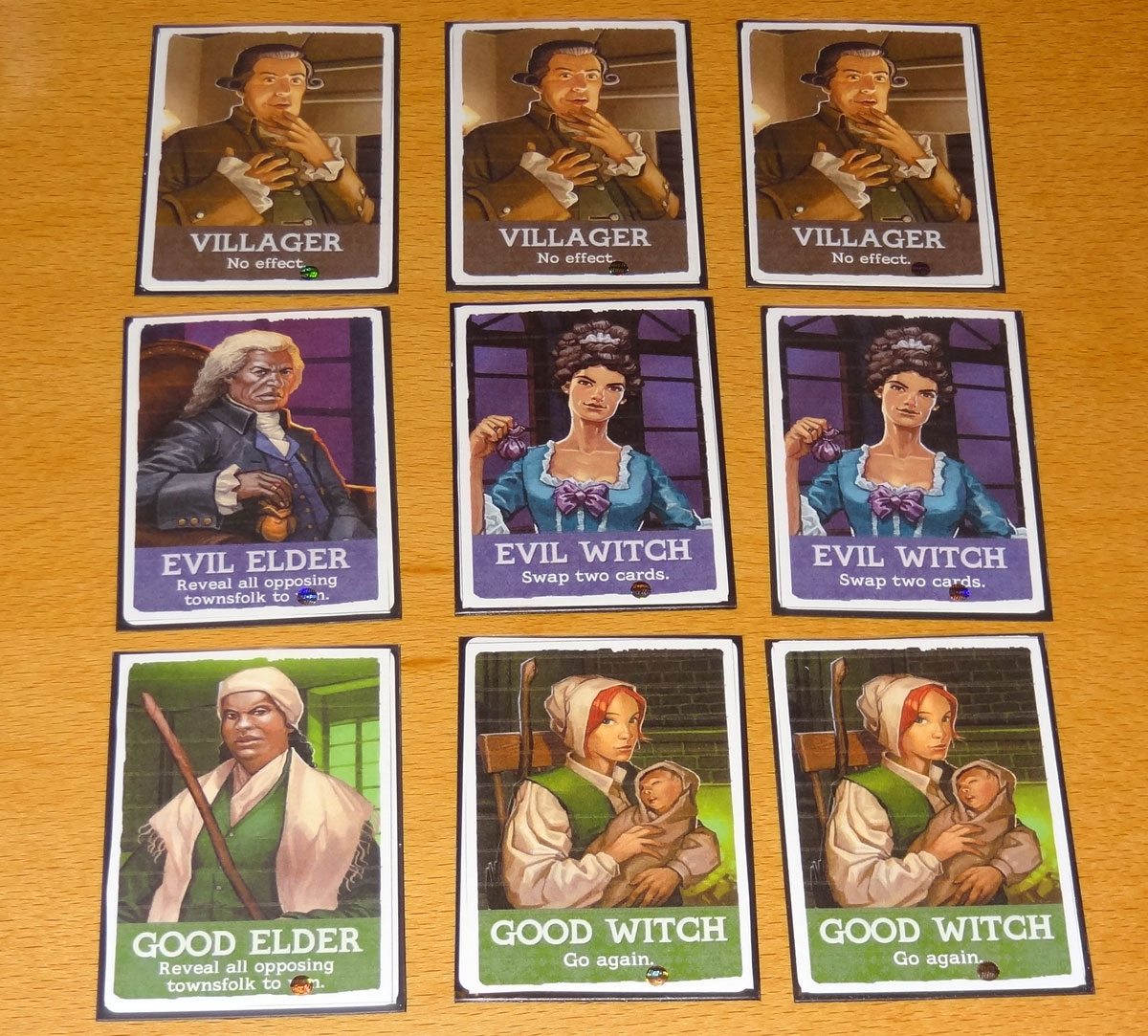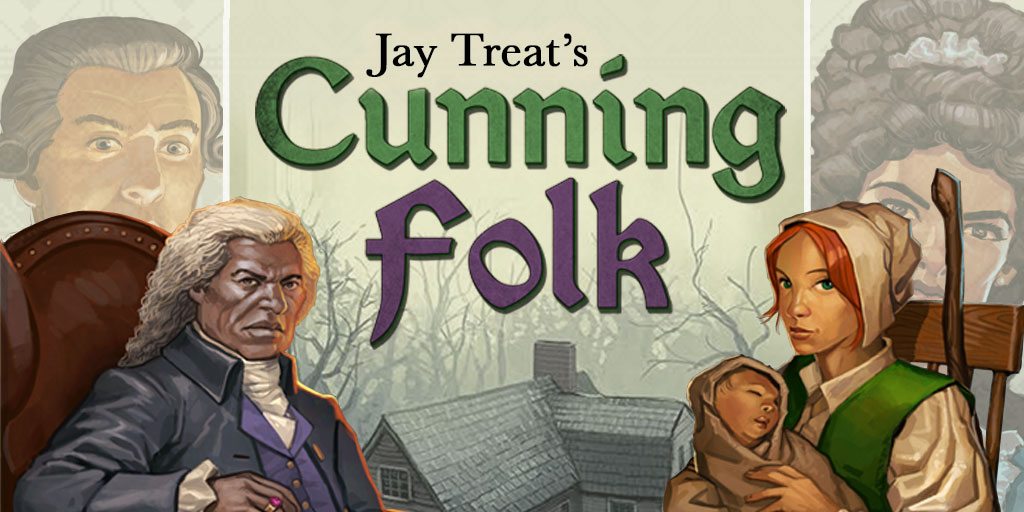The village of Ipswich is overrun with witches, both good and evil–can you expose the witches? But be careful: if you’re caught lying, the townsfolk will suspect you’re a witch, too. Here’s a clever little game for Cunning Folk.
At a glance: Cunning Folk is a bluffing/deduction game for 2 to 4 players, ages 8 and up, and takes under 10 minutes to play. Since it is a bluffing game, players who are bad at lying will be at something of a disadvantage–something to take into account before playing with your children. It’s currently seeking funding on Kickstarter, and you can pledge for a copy of the game for as little as $5 (plus shipping) or as much as $25 for the deluxe version.
New to Kickstarter? Check out our crowdfunding primer.

Components:
17 cards: 2 Good Witches, 1 Good Elder, 2 Evil Witches, 1 Evil Elder, 3 Villagers, and 4 Judgment
That’s essentially it! Depending on the version you pledge for, you can also get the Wallet edition, which comes with a little vinyl wallet for the game. The Deluxe version comes with cardboard tiles instead of cards in a jute bag, and bracelets to mark accused players (instead of the judgment cards).
If stretch goals are hit, there will be additional characters added, which can be swapped in for the Villagers to mix up the game.
The illustrations, by Fabrice Weiss (who also illustrated Seven7s and Pretense), are nicely done and fit the theme well.
How to Play
You can download the rules here, or even get a free Print and Play version here.
The goal of the game is to expose the opposing team of witches, or be the last player left when everyone else is ostracized.
To set up, you take the 9 Townsfolk cards, shuffle them, and set them face-down on the table in a 3×3 grid (or however you like). The Judgment cards are place to the side.
On your turn, you pick a card, look at it secretly (if it’s face-down), and put it back. Then you declare a role–you can tell the truth about what you saw, or lie about it. Everyone else has a chance to challenge you. If challenged, then you must flip the card face-up to reveal what it is. If you were telling the truth, or if nobody challenges you, then you take the action associated with the role you declared.
- Good Witch: Go again.
- Evil Witch: Swap two cards.
- Good Elder: Identify the three evil cards to win.
- Evil Elder: Identify the three good cards to win.
- Villager: No action.
The first time you are wrong–for instance, if you challenge somebody and they were telling the truth, or you lied and were caught–then you take a Judgment card with the “Suspected” side showing. If you are wrong again, you are “Ostracized” and are out of the game.

There are some finer details about how it all works, but that’s essentially it. If you’re the last player remaining, you win. Otherwise, you’ll have to declare one of the two Elders and identify all three of the opposing cards to win. (If you declare the Elder, you reveal one at a time until you either find all three or are wrong, at which point your turn ends and you are either Suspected or Ostracized.)
The Verdict
Cunning Folk is another title in Button Shy’s line of “wallet” games, each consisting of a very few cards in a little vinyl wallet for extreme portability. I love the idea, because it’s fun to have a game that you can just carry with you in case the need arises. Despite its tiny size, Cunning Folk is a lot of fun.
I got a prototype of Cunning Folk to try out, and it’s a blast. It has elements that remind me of some other bluffing games: both Coup and Mascarade allow you to declare any role to take its action–but only if you don’t get challenged. Also, like Mascarade, when you “swap two cards” with the Evil Witch, you get to put them under the table, decide whether or not to swap them, and then put them back–so you know whether they’ve been swapped, but you don’t get to peek at them yourself. Any face-up cards get turned face-down when swapped, and I like that a lot–it reintroduces that element of doubt when people have started to figure things out.
In Cunning Folk, though, you’re all working off a common set of cards, which means that other players may have seen the card you’re about to pick up. Do you peek at the same one somebody else used, to check if they were lying? Or do you peek at a different card, knowing that you can lie about it and nobody will know for sure? Your ability to bluff, of course, depends on what other people have seen. If somebody already knows where both Evil Witches are, then you’re going to get called when you declare a different card to be an Evil Witch. The Elders can also be traps–you really don’t want to pick one up when somebody else knows what it is, unless you’re ready to identify the three other cards to win.
It’s such a simple idea, but the play is fascinating. It’s quick, and you’ll end up playing several times in a row as you try to figure out when the other players are bluffing or telling the truth.
I’m impressed with the gameplay that designer Jay Treat has managed to squeeze out of just 13 cards. The game is already funded and on its way to hitting some stretch goals to add a few new characters. I’ve seen a couple of these already (though I haven’t played with them yet), but you swap out Villagers and put in the other characters. The Liar forces you to declare some other role, because you can never declare yourself a Liar. The Vagrant must swap places with another card. There are a couple others, but they haven’t been revealed in the Kickstarter campaign yet so I’m keeping them face-down. You’ll just have to trust me.
For more information, visit the Cunning Folk Kickstarter page!




